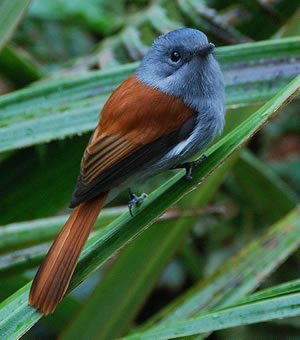The Earth's rainforests are full of insects, and many of the birds there have evolved to exploit this abundant source of food.
Flycatchers
There are two groups of birds known as flycatchers.
Those from the Americas, the tyrant flycatchers, are more primitive and are thought to have had the same ancestors as manakins.
Although the Old World species have the same lifestyle, their origins are different. All flycatchers are insectivorous, and many catch prey in the air by making short sallies from a vantage point.
 The Old World flycatcher is an attractive, brightly plumaged bird.
The Old World flycatcher is an attractive, brightly plumaged bird.
The paradise flycatcher of Southeast Asia, has long tail feathers and an erect crest.
The tyrant flycatcher are comparatively drab, with green and brown feathers.
Motmots
Many insectivorous birds, such as motmots, make swift darts from a vantage point and catch prey on the wing.
Motmots live in the Central and South American rainforests.
The rufous motmot sits for long periods without moving, but is quick to seize suitable prey. After a successful capture, the motmot returns to its perch, where it impales the insect on the branch before eating it.
Both the male and female excavate a tunnel in which to nest.
Puffbirds
The puffbird of the Amazon rainforest also digs a tunnel nest.
Like the motmot, this small birds sit motionless on branches, but are alert to passing insect life
Jacamars
The jacamar is about the same size as the puffbird, and has a similar long, pointed bill,
It is related to the puffbird and also lives in the South American rainforest.
However, the jacamar's electric iridescent plumage and slender form contrast with the puffbird's buff feathers and chunky shape.
While the puffbird tends to be sluggish and silent, the jacamar is energetic and vocal.
The jacamar makes a fine display while catching prey, since it takes the brightest dragonflies and butterflies on the wing.
Constantly on watch, the jacamar darts out, grasps the insect and, with its prey fluttering in its long slender bill, returns to its perch. There it hammers the insect rapidly and loudly for some minutes, until the wings fall to the ground. It then eats the insect's body.
Some jacamars also feed on small, inconspicuous insects.
Potoos
Potoos have enormous gaping bills and long wings.
The potoo resembles the flycatchers in its hunting methods. It darts out from its perch to catch moths, fireflies and other insects in its huge mouth.
A nocturnal hunter, the potoo spends much of the day perched in a strange, vertically elongated pose on a tree stub.
Camouflaging plumage combined with this pose makes the potoo seem to part of the tree.
When it incubates its eggs, the potoo assumes the same camouflaging posture, but faces into the tree trunk. Nestlings too adopt this pose.
The potoo is sometimes called the "poor-me-one". The nickname comes from its cry, which can be heard at dusk and dawn and by moonlight.
Antbirds
The antbirds of South America are varied in shape, behavior and feeding habits.
The most well known antbirds are those that have an opportunist association with the marauding bands of army ants that roam the floor of the rainforest.
While most creatures will run from a column of thousands of foraging army ants, antbirds take advantage of the situation to capture spiders, scorpions and insects disturbed by the ants. They do not eat the ants themselves.
When an antbird discovers an ant column, it sings, attracting other antbirds to the site.
Several different species of antbird will approach an army ant column, and a hierarchy develops in which the largest species or individual supplants subordinate, smaller species in choice foraging positions.
These frustrated subordinates will often resort to robbing the army ants of their captures. The best foraging positions are branches just above the advancing column. From its perch, the antbird darts down to seize a fleeing creature and bounces back with its prey.
Woodcreepers and Woodpeckers
Woodcreepers, which live in Latin America, and woodpeckers, which can be found worldwide, have evolved the ability to remove insects from wood.
Between 8 and 15 inches (20 and 38cm) long, woodcreepers have strong, stiff tail feathers, which they use as supports during climbing. Though their bills are strong, they forage by moving spirally up a tree, extracting insects from crevices.
Woodcreepers are also attracted to ant columns by the songs of antbirds.
Woodpeckers dig into bark and wood to extract burrowing insect larvae. They use their toes, which have strong curved claws, to anchor them to trees. They use their tails as struts.